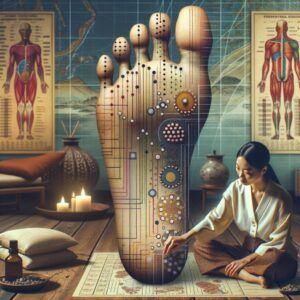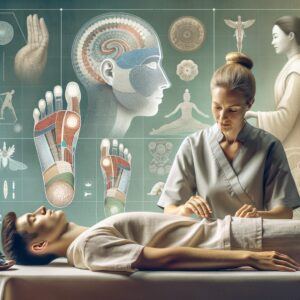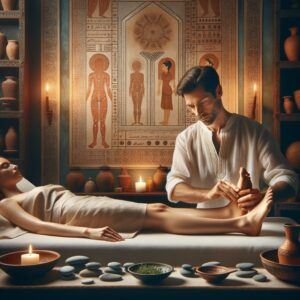Those seeking alternative medicine have found solace in foot reflexology, a centuries-old therapy with roots in Egypt and China. The premise of this form of alternative medicine is that different places on the feet represent various parts of the body. The potential benefits of foot reflexology, including reduced stress and improved circulation, have garnered attention as interest in alternative medicine continues to grow.
As a result of its widespread use, however, concerns have arisen regarding its safety and scientific validity. Foot reflexology is a unique blend of tradition and modernity; this essay examines its complexities, misconceptions, benefits, and the reality behind it.

Nourish Your Body, Fuel Your Potential—Start with GreatLife Supplements.
1. An Introduction to Foot Reflexology: A Modern Take on an Age-Old Practice
The ancient healing arts of China and Egypt are the ancestors of modern foot reflexology, which has been around for thousands of years. Acupuncturists practice this holistic form of medicine on the premise that specific points on the feet represent various parts of the body. Those who practice acupressure aim to enhance health and accelerate recovery by applying pressure to specific points on the body.
These days, many people are turning to foot reflexology as a supplementary or alternative method of treating a wide range of medical conditions. The potential advantages, including reduced stress, increased circulation, and enhanced relaxation, combined with its non-invasive nature, are its main selling points. If you suffer from chronic discomfort, such as arthritis or migraines, you may want to try reflexology.
Contemporary foot reflexology treatments integrate traditional procedures with modern scientific discoveries, continuing to progress from its ancient origins. To meet the unique requirements of each patient, modern practitioners often integrate modern anatomical knowledge with traditional wisdom.
One possible explanation for the recent surge in foot reflexology is the growing popularity of holistic health practices, as people seek more natural ways to care for themselves. Practitioners and clients alike would benefit from familiarizing themselves with the practice’s background and its current role in healthcare, as it continues to gain popularity.
Many people believe that foot reflexology is helpful since it complements other therapies, even if some people are wary about it because it hasn’t been scientifically validated as much as conventional medicine.
The fascinating combination of ancient tradition and modern application in foot reflexology is a tribute to humanity’s continuing quest for balance between mind, body, and spirit. It can be utilized as part of a larger integrated health plan or for self-care and relaxation.

Strengthen Mind, Body, and Purpose with Every Dose.
2. Is There Any Truth to the Claims Made by Foot Reflexology?
The supposed health advantages of foot reflexology have brought this ancient therapy into the spotlight. The foundational idea of reflexology is that specific locations on the feet are believed to correspond to various systems and organs in the body. Pressure applied to these spots, according to practitioners, can open up energy channels and accelerate the healing process.
The effectiveness of foot reflexology is still up for discussion among scientists. There is a lack of conclusive data to support its efficacy; however, some studies have shown possible benefits, such as reduced pain and improved relaxation. Many studies have shown that patients’ perceptions of their recovery, influenced by the placebo effect, heavily impact the effectiveness of reflexology treatments.
Anxieties in the feet can trigger signals to travel up brain pathways to other areas of the body, according to one hypothesis of foot reflexology. Potentially reducing stress and improving overall health, this stimulation may stimulate the release of endorphins or alter responses in the autonomic nervous system.
Nevertheless, skeptics contend that there is a lack of thorough scientific proof for numerous assertions linked to foot reflexology. They highlight the necessity for more detailed studies with larger samples and controlled conditions, and expose methodological shortcomings in current studies.
Notwithstanding these obstacles, it’s not possible to discount anecdotal information from people who have had good results. After sessions, many people report feeling refreshed and invigorated, which may have a positive impact on their overall health by reducing their stress levels in the long run.
Ultimately, anyone contemplating foot reflexology must conduct thorough research before beginning treatment, as the technique continues to amaze its practitioners and patients. To establish reasonable expectations about the benefits and limitations of reflexology, it is recommended to consult with healthcare professionals before incorporating it into one’s wellness routine.

Your Health Journey Deserves the Best—Choose GreatLife Quality.
3. Does Foot Reflexology Have the Power to Eliminate Toxins?
A much-discussed but still-debatable component of foot reflexology is the idea that it can aid in detoxification by stimulating the release of toxins from the body. Those who believe in the practice of acupressure point therapy for the foot say that by applying pressure to specific regions, it can improve organ function and make it easier for the body to rid itself of toxins. There is a lack of scientific evidence to back up these statements.
When it comes to the mechanics of detoxification, the human body has its complex systems, mainly through the kidneys and liver. These organs are constantly at work removing harmful chemicals and waste from our blood. Reflexology doesn’t directly impact the body’s natural detoxification processes, but it does promote relaxation and improved circulation, which may theoretically support overall health.
Many people who are critical of foot reflexology point out that there is no evidence to support the detoxifying claims that are typically made about it. In alternative medicine, the term “toxins” is often used without specificity, definition, or quantifiable criteria.
Due to this lack of clarity, it’s challenging to determine whether the claimed advantages are attributable to the removal of toxins or simply to the increased relaxation and stress alleviation that participants report during sessions.
Regardless, anecdotal evidence suggests that some people experience a sense of revitalization following foot reflexology treatments, with some even attributing their enhanced well-being to the perceived cleansing effects. Practitioners and clients should both be skeptical of such assertions and keep in mind that everyone’s experience is unique.
Ultimately, there’s a lack of evidence supporting the purported detoxifying effects of foot reflexology, despite the treatment potentially having positive effects on circulation and stress levels. Anyone thinking about trying this treatment should go into it with reasonable expectations about how much poison it can release.
4. When Foot Reflexology Injuries Occur During Treatments, What Does It Indicate?
For individuals new to foot reflexology, the prospect of experiencing discomfort during a session can be unsettling. The good news is that there are several reasons why this happens frequently. To determine if the pain is natural or a sign of something more serious, it’s essential to understand the cause.
Foot reflexology is a form of alternative medicine that focuses on the premise that specific pressure points on the feet correspond to various bodily systems and organs. People have different pain thresholds and sensitivity levels; thus, the sensation they feel when this pressure is applied might fluctuate significantly from person to person. What some people may regard as gentle pressure may be quite painful for others.
Aches and pains might be signs of internal imbalances or tensions. If a reflexologist experiences pain at a specific location, it may be an indication that the related organ or system is overworked or not functioning correctly. If this is the case, ongoing sessions may eventually help restore harmony.
But you shouldn’t turn a blind eye to severe or ongoing pain. It can mean the practitioner is using incorrect technique or is taking a harsh approach that you aren’t comfortable with. If you feel any pain during your reflexology session, you must tell your reflexologist so they can modify their techniques appropriately.
Additionally, existing health issues such as neuropathy, plantar fasciitis, or arthritis may make reflexology treatments more painful. Individuals suffering from these conditions should consult their doctor before undergoing reflexology.
Overall, it’s normal to feel some discomfort during foot reflexology sessions due to differences in body sensitivity and imbalances. However, if you experience severe pain, it’s essential to talk to your practitioner and possibly a doctor to make sure you’re safe and getting the most out of your treatment.

Take Charge of Your Health—One Supplement at a Time.
5. Testimonial Evaluation: How Verified Is Foot Reflexology?
Many in the medical and alternative medicine communities have questioned the veracity of foot reflexology as a treatment method. Although it has been practiced as a holistic treatment therapy since ancient civilizations, current scrutiny requires evidence-based justification.
Anecdotal evidence from numerous individuals who have experienced stress relief, improved circulation, and enhanced well-being after receiving foot reflexology treatments lends support to the practice. These first-hand accounts are a big reason why it’s so well-liked and respected in the complementary health community.
However, when viewed from a scientific perspective, we encounter conflicting findings. There’s a lack of consistency across larger samples or rigorous methodologies; however, some studies do show advantages, such as lower anxiety and discomfort levels in specific individuals. When people in trials report good results, the placebo effect is often considered to be the reason why.
Some people think reflexology is more art than science, as there isn’t any solid evidence to support it or a known mechanism that explains how pressing certain places on the feet leads to changes in other areas of the body. To definitively demonstrate any causal linkages, they stress the need for further study using randomized controlled trials.
Although there are valid concerns, many practitioners insist that foot reflexology should not be disregarded entirely because it is non-invasive and has a lower risk profile than traditional medical treatments. Instead of promoting it as a panacea, it is more commonly suggested as a component of a comprehensive health strategy.
Ultimately, those seeking alternative therapies to complement their overall health routine still find value in foot reflexology, despite conventional science not yet providing conclusive evidence of its effectiveness beyond relaxation and stress reduction. Both supporters and detractors of this age-old technique are waiting for more conclusive answers as researchers work to uncover the practice’s actual potential.

Feel the Difference of Tailored Wellness—Get Started Now.
6. What Not to Do Following a Foot Reflexology Session: Post-Session Care
To get the most out of your foot reflexology session and minimize any pain or side effects, it’s essential to follow these steps afterward. Do not drink alcohol right after your session; this is one of the main pieces of advice. Drinking alcohol can reduce the efficacy of reflexology by interfering with the body’s natural detoxifying mechanisms.
Also, after your session, it’s best to ease back into it with light to moderate exercise. After receiving reflexology, your body may be in a state of relaxation and rebalancing; engaging in strenuous physical activity immediately afterward may have the opposite effect and cause you to feel exhausted. If you feel the need to move about, try light activities like walking or stretching instead.
It’s crucial to stay hydrated after reflexology, but avoid drinking too much water at once. Although water aids in flushing out session-related toxins, consuming excessive amounts of water can lead to an electrolyte imbalance and renal overload. Avoid drinking too much water in one sitting; instead, aim for moderate intake throughout the day.
Also, it’s best to avoid eating anything too heavy immediately following your workout. To support your body’s internal adjustments and healing, it is best to have light snacks and meals, allowing your digestive system to conserve energy.
Finally, avoid situations that can cause tension right after reflexology. By re-igniting the body’s tension responses, emotional stress might counteract the relaxing effects of treatment. Reflexology is most effective when used in conjunction with other relaxation techniques that promote both physical and mental calm, such as reading or meditation.
People can get the most out of their foot reflexology sessions and help promote long-term wellness by following these guidelines after their sessions.
7. Who Is at Risk for Adverse Reactions to Foot Reflexology?
Even though foot reflexology is often thought of as a harmless complementary therapy, there are some things to keep in mind. People can make better judgments about the practice’s suitability for them if they are aware of these.
To begin, precautions or complete abstinence from foot reflexology should be taken by anyone with specific medical issues. The pressure used during sessions may worsen symptoms for people with circulation disorders, including severe varicose veins or deep vein thrombosis (DVT). In a similar vein, individuals with gout or active foot infections should postpone reflexology until their condition has improved.
Women who are expecting a child should talk to their doctor before trying foot reflexology. Although there is some anecdotal evidence that tapping on certain foot areas can stimulate labor, the scientific data is inconclusive. Pregnant women need to consult experts to make sure they are safe.
Also, be cautious if you have osteoporosis or any other condition that affects your bones; applying too much pressure could cause fractures or worsen your pain. Reflexology may also be a good option for individuals who have recently undergone foot or lower leg surgery, provided they have fully recovered.
People who have diabetic neuropathy or other forms of nerve loss in their feet should also exercise caution when practicing foot reflexology. If excessive pressure is accidentally applied due to the altered sensation, it could cause harm.
Finally, someone’s allergies could trigger an adverse reaction if the oils or lotions used in the sessions contain substances to which they are susceptible. We recommend that consumers inform us of any known sensitivities in advance and request alternative items if necessary.
To summarize, while many people find foot reflexology beneficial, those who fall into these risk categories should talk to their doctors before doing this treatment.

Invest in Your Well-Being—GreatLife Makes It Easy.
In essence:
Practitioners and clients alike are still drawn to foot reflexology for its potential to alleviate stress and improve overall health; however, anyone considering this therapy needs to approach it well-informed. Although there’s conflicting scientific evidence about its effectiveness beyond relaxation and stress relief, many people still find it beneficial as part of a comprehensive wellness regimen. The best way for individuals to incorporate this ancient therapy into their lives safely and successfully is to educate themselves on the history and modern uses of foot reflexology. When in doubt, they should consult healthcare specialists.

